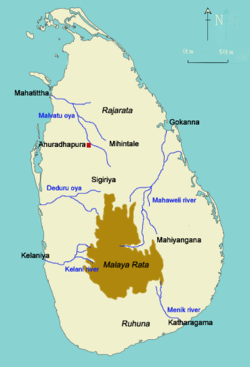Anuradhapura Kingdom
| Kingdom of Anuradhapura | ||||||||||
| අනුරාධපුර රාජධානිය | ||||||||||
|
||||||||||
|
The major ports and towns of Sri Lanka during the Anuradhapura period. Rajarata, Malaya Rata and Ruhuna, the three sections the country was divided into, are also shown
|
||||||||||
| Capital | Anuradhapura | |||||||||
| Languages | Sinhala | |||||||||
| Religion | Buddhism | |||||||||
| Government | Monarchy | |||||||||
| King | ||||||||||
| • | 377 BC-367 BC | Pandukabhaya | ||||||||
| • | 982–1017 | Mahinda V | ||||||||
| History | ||||||||||
| • | Established | 377 BC | ||||||||
| • | Disestablished | 1017 | ||||||||
| Area | 65,610 km² (25,332 sq mi) | |||||||||
|
||||||||||

The flag used by Dutthagamani and subsequent rulers.
The Anuradhapura Kingdom (Sinhala: අනුරාධපුර රාජධානිය, Tamil:அனுராதபுர இராச்சியம்), named for its capital city, was the first established kingdom in ancient Sri Lanka and Sinhalese people. Founded by King Pandukabhaya in 377 BC, the kingdom's authority extended throughout the country, although several independent areas emerged from time to time, which grew more numerous towards the end of the kingdom. Nonetheless, the king of Anuradhapura was seen as the supreme ruler of the country throughout the Anuradhapura period. Buddhism played a strong role in the Anuradhapura period, influencing its culture, laws, and methods of governance. Society and culture were revolutionized when the faith was introduced during the reign of King Devanampiya Tissa; this cultural change was further strengthened by the arrival of the Tooth Relic of the Buddha in Sri Lanka and the patronage extended by her rulers.
Invasions from South India were a constant threat throughout the Anuradhapura period. Rulers such as Dutthagamani, Valagamba, and Dhatusena are noted for defeating the South Indians and regaining control of the kingdom. Other rulers who are notable for military achievements include Gajabahu I, who launched an invasion against the invaders, and Sena II, who sent his armies to assist a Pandyan prince.
...
Wikipedia

